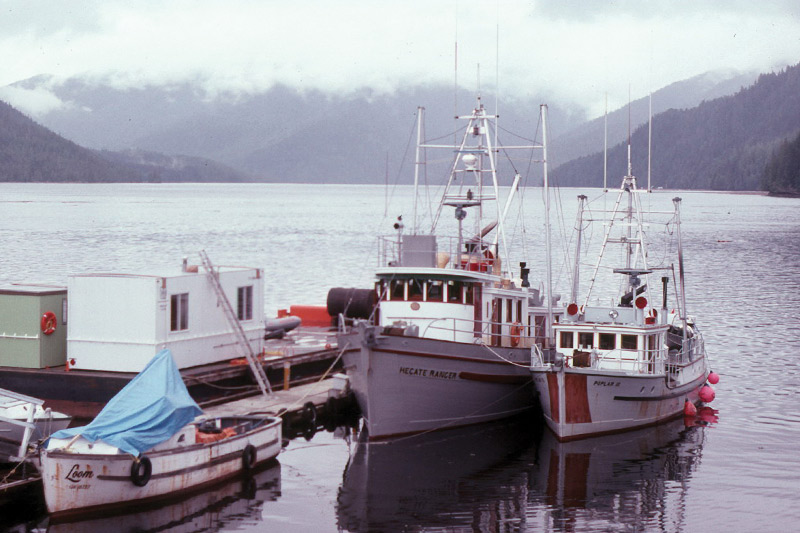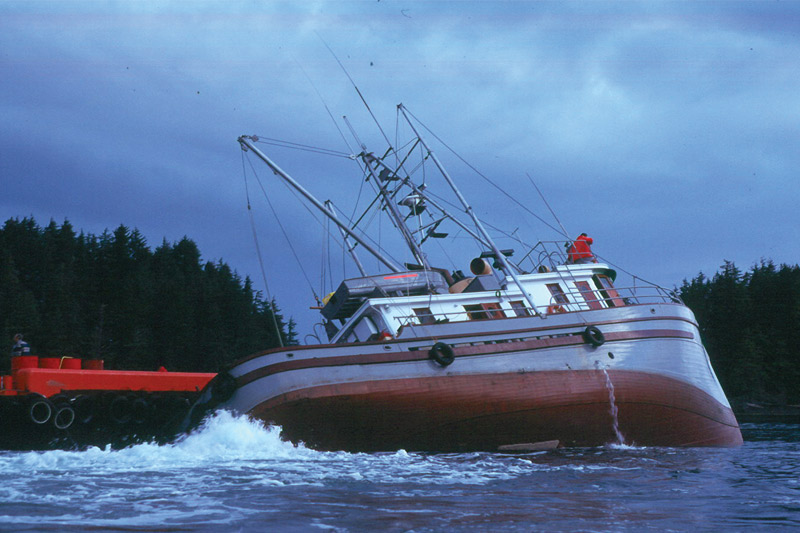
 Our longtime friends Ken Lane and Kirsten Thomassen invited my husband Garth Wilcox and me to come aboard their motoryacht, the Hecate Ranger, to Victoria for the Classic Boat Show this past summer. It didn’t take but a second to say yes. I had already helped bring their new “baby” down from Port Townsend after they’d commissioned her, although “baby” might be a serious understatement for the gorgeous 65-footer they’d acquired in the fall of 2015.
Our longtime friends Ken Lane and Kirsten Thomassen invited my husband Garth Wilcox and me to come aboard their motoryacht, the Hecate Ranger, to Victoria for the Classic Boat Show this past summer. It didn’t take but a second to say yes. I had already helped bring their new “baby” down from Port Townsend after they’d commissioned her, although “baby” might be a serious understatement for the gorgeous 65-footer they’d acquired in the fall of 2015.
For Ken and Kirsten, longtime sailboat racers, venturing into motor boats was a paradigm shift. They weren’t in the market for another boat. At that point, they already had their hands full with both a Thistle and Thunderbird sailboats. But the previous owner of the Hecate Ranger, John Woodard, had recently died. The vessel had been his love, a boat he’d doted upon and lived aboard for nearly 20 years. Ken and Kirsten realized this beauty needed a new caretaker. That led to tours of the vessel, which sparked fantasies of possibly living aboard.
Though the vessel never officially went on the market, Ken and Kirsten soon considered themselves serious buyers—understandable once you see her. The vessel is eye candy for the wooden boat aficionado with clean lines and a stately beauty. She has stain-glassed windows and is filled with antique brass lamps, artwork, finely carved furniture, and oriental carpets that could grace a fine craftsman home. Everywhere you look detailed flourishes—such as forged bronze fittings, door handles and signage, moldings to support shelving, and nautical-themed extras—add to her appeal.
She’s carefully outfitted with all the comforts of home, including a fridge/freezer, microwave, trash compactor, washer/dryer, and more. With four staterooms, there’s plenty of room for entertaining inside and on the upper or lower deck of the fantail. Even a diehard sailor is vulnerable to her charms, and I, too, fell under her spell.

After considerable maintenance at Haven Boat Works in Port Townsend, Washington, Ken and Kirsten were eager to enjoy her. That first time out of the yard in early 2016, I joined them to guide this beauty down the Sound and back into the slip across from the Bainbridge ferry dock where she’d spent many years. There she holds a commanding view of Eagle Harbor from her fantail, but Ken and Kirsten planned to explore farther afield in the Salish Sea aboard their “new” boat.
On one of their first cruises, they headed to Port Townsend for the start of the second Race to Alaska (R2AK) to cheer on their daughter and son-in-law, who were racing aboard Jungle Kitty. Ken and Kirsten anchored Hecate Ranger on the start line, and I mean on the start line, which they discovered shortly before boats began lining up. Needless to say, they had a front row seat for the starting sequence. Garth and I were sorry to miss that trip up the Sound for the race start and the chance to relax aboard in the San Juan Islands while their kids slogged the rest of the way to a second-place finish in Ketchikan, Alaska. We were not about to miss another chance to cruise this luxurious yacht.
Despite her appearance, Hecate Ranger was not born of luxury. She began her life as a workboat in the British Columbia Forestry Service fleet, one of hundreds of vessels that plied the rough waters in and around British Columbia. These boats connected lonely rough-and-tumble logging communities and station outposts spread out over thousands of miles along the coastline. According to Michael Coney, author of Forest Ranger, Ahoy (Porthole Press, Sidney BC, 1983), “Since 1911 the wooden ships of the Forest Service have fought the seas, bearing their crews across storm-tossed straits, through tide-torn channels, up inlets where the wind howls like an animal, wherever there is work to be done, wherever the job takes them…”

Life on the rugged west coast of British Columbia was hard. Roads were few and air transport in its infancy; so the ocean was the highway for loggers, fisherman, and other hardy people who lived in isolated groups on the edge of the rocky wilderness.”
By the end of WWI, logging was on the upswing. New ranger stations opened, and the Forest Branch had accumulated a fair-sized fleet. Initially, I assumed all forest boats looked like the Hecate Ranger, but soon learned that nearly every boat was different. According to Coney, there were eleven Assistant Ranger launches that were 32’ long, built of fir and cedar, nicknamed “Blimps” because their portly styling was reminiscent of the wartime non-rigid airships. Some of them were rented, but most were purchased from among the serviceable boats available at the time. They patrolled and policed logging operations in diverse conditions, and were also used for administration, inspections, and fire suppression. The fleet transported equipment and tree seedlings, and also served as accommodations for the rangers. As Coney notes drily in his book, some were more suitable than others.
The Forestry fleet continued to expand. In the early sixties, John Paynter, the head of the B.C. Forest Service, wanted a boat capable of operating across Hecate Strait and around the Queen Charlotte islands, now known as Haida Gwaii. The Hecate Ranger was designed to be that boat. She was constructed of yellow cedar in 1962 by West Coast Salvage, a marine salvage shipyard on False Creek, with a keel and a keelson, sister keels running alongside the keelson, and a false keel on the bottom. Her keel structure is T-shaped, about 4’ wide and 4’ deep to protect her in the event that she ran onto a rock.
She was built to be super strong, with 2” thick planking and an oak frame 10” center-to-center, for use in a high-stress environment. These were quality construction materials that were once cheap and abundant: clear, old-growth timber. All equipment and outfitting was commercial quality that was easy to repair and maintain. Initially she had a rolling problem, so shortly after she was built they added lead ballast. Unfortunately, it tended to disappear back in the days when the price of lead rose to a high-market value. The Hecate Ranger was the largest boat ever built for the B.C. Forest Service and quickly became the queen of the fleet.

Despite her graceful lines, Hecate Ranger was a workboat, and she, too, had her moments of embarrassment. In July 1979, while getting underway in the early hours, the Hecate Ranger struck Datum Rock in Chatham Sound. There she sat, high and dry, until they could pull her off. The official account of the incident blamed an overreliance on older radar units with idiosyncrasies, but some of the co-ed crew aboard reported later that it might have had more to do with a lack of attention on all parts resulting from hangovers after a wild party the evening before.
When the B.C. Forestry fleet was no longer needed, it was disbanded, and most of its vessels sold to private parties. Like all the Forest Service boats, Hecate Ranger was gray when Frank Huff bought the boat from the B.C. government in 1984. She had originally come with berths for 12 and a galley that was walled off from the mess hall, but these features were changed in her early days of private use.
Huff took the vessel to Alaska a number of times. Batwings had been added for stabilizing to reduce roll, though it is unclear when this modification occurred. It was an unusual idea that turned out to be a bad one.
When John Woodard bought the boat, he immediately made modifications. One of the first things to go were the batwings. In 2001, John Woodard revamped the boat extensively at Anderson Shipwrights next to the old Marco drydock on the south side of the Ship Canal in Seattle. He removed the tow winch, added the fantail and the overhead walkways, and extended the upper deck. He replaced and reinforced the bulwarks and ladders to the upper deck. He also added the many touches that gave her a regal style. Like Cinderella, she was transformed into a beauty. With all the comforts of home, John enjoyed living aboard her for nearly 20 years.
In 2015, when Ken Lane first bought the boat, he took her to Haven Boat Works in Port Townsend. The primary task was to replace the original spikes that fastened the hull and to re-caulk all the seams, but he tackled many other projects as well while the boat was pulled apart.

With his newly-restored boat ready, Ken Lane reached out to fellow B.C. forest fleet owners. They were ecstatic to have Hecate Ranger return to the fleet association, which formed in 1992 after the B.C. Ranger vessels were sold into private hands. It was Norm Wright, a new owner living on the retired Ranger launch Nesika, who contacted other owners and suggested a B.C. Ranger Rendezvous.
The first gathering in 1992 marked the beginning of a long-standing tradition that has continued for more than 20 years. Every year there’s a squadron reunion, usually scheduled during the long Canadian weekend in late August. Each year, different boats attend and the fleet attempts to keep track of as many B.C. Ranger vessels as they can. Many of these former B.C. Rangers can be found sprinkled around Salish Sea marinas today. A rugged vessel with “Ranger” in its name might well be one of the former fleet.
In 2017, the fleet chose to coincide the Rendezvous with the Victoria Classic Boat Festival. Eager to see all these classic vessels, Garth and I were keen to join Ken and Kirsten for the fun. We all had a wonderful weekend meeting fellow owners of the B.C. Forest Rangers and exploring their boats. This was the first time that Hecate Ranger had attended a Rendezvous in many years, and members were excited to see her again. As Ken Lane told fellow fleet members when they gathered aboard for cocktails, tours, and photos, “It’s an honor to be the caretaker of a vessel with such a rich history, even for a little while.”